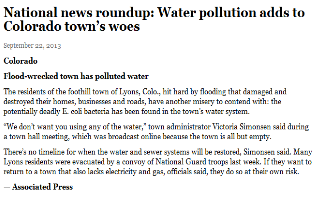On September 22, 2013, the Washington Post published a short article stating that water pollution plagued a flood-wrecked town in Colorado. Tumultuous rains hit the town of Lyons, causing a great flood that destroyed homes, buildings, and roads while water and sewer systems were reported to have been contaminated by potentially deadly E. coli bacteria. Town administrator Victoria Simonsen warned residents not to use the water and added that there was no timeline regarding the restoration of the town’s sewer systems.

When a flood occurs, the water collected will carry with it all the pollutants from the streets, parking lots, construction or industrial sites and send them to lakes, rivers, and oceans. This polluted runoff is called ‘stormwater’ and it can be very deadly if left unchecked.
In order to prevent this problem from escalating, long-lasting stormwater systems need to be put in place. This type of system prevents flooding and removes pollutants before they become part of the main source for drinking water. Without stormwater systems, the stormwater runoff will be forced to flow into the nearest body of water without treatment. This means that the water will be contaminated with pollutants including pet wastes, pesticides, litter, gasoline or anything that can be dissolved or swept away by water.
Two types of reliable storm water systems are commonly used, namely the retention and the detention systems. The former is designed to allow water to seep through the ground without directly discharging it to natural water bodies while the latter, being the most recognizable system, allows material to settle and be absorbed.
Stormwater systems are essential, so they have to be as effective and strong as the StormChamber Systems from HydroLogic Solutions. It is also important to keep these systems functional to ensure quality water maintenance. If maintained properly, not only will they stop water from becoming polluted but they can also prevent extreme flooding.
Water pollution affecting drinking water is a problem that can be avoided even when a flood hits. Once a good stormwater system is installed, non-toxic and natural byproducts can be safely redistributed to make drinking water safe once again.
(Info from National News Roundup: Water Pollutions Adds to Colorado Town’s Woes, Washington Post, September 22, 2013)





